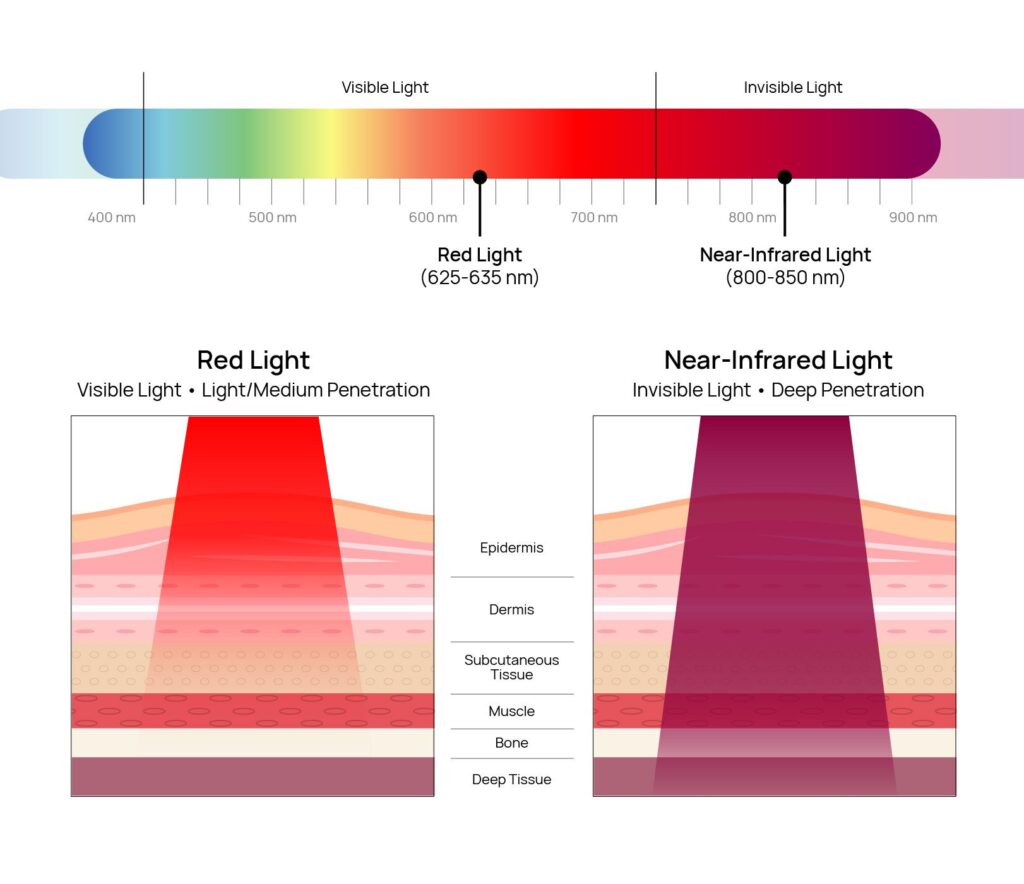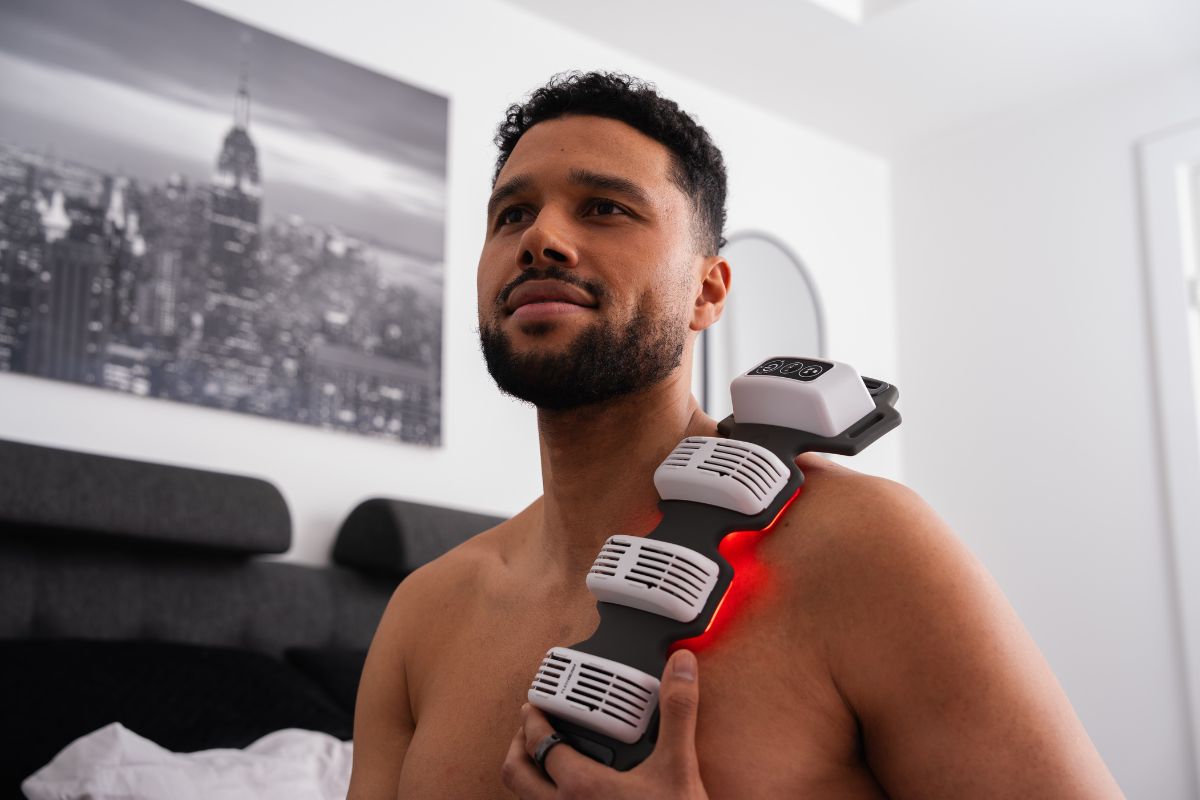Your cart is currently empty!
Light Therapy: Everything You Need to Know
Table of Contents
Light therapy, also known as photobiomodulation, refers to various forms of therapy that use photonic energy of light to treat a wide array of health issues. Different light sources and different light wavelengths are used for various treatments.
Types of Light Therapy
Types of light therapy include:
- Color Light Therapy, also known as chromotherapy, which uses color light set at a specific wavelength to treat certain mental and physical health conditions such as high blood pressure, depression, stress, anxiety, skin infections, etc.
- Low-level Laser Therapy, also known as old laser therapy or LLLT, which involves the use of relatively low light energy (less than 100-200 mW) to decrease pain and inflammation, stimulate collagen metabolism and wound healing, and promote fracture healing.
- Light Box Therapy, also known as phototherapy, consists of exposure to artificial light in order to treat conditions like eczema, psoriasis, jaundice, seasonal depression, and circadian rhythm sleep-wake disorders.
- LED Light Therapy which uses light emitting diodes of different therapeutic wavelengths and colors, most commonly red and blue, to treat miscellaneous skin conditions, promote anti-aging effects, as well as reduce inflammation.
However, when people think about using light for therapeutic purposes, there are two main types that everyone thinks about: SAD treatments, and red or blue light therapies. Therefore, let’s dive deeper into these two options.
Bright Light Therapy for Seasonal Affective Disorder
Seasonal Affective Disorder (SAD), or seasonal depression, is a type of depression primarily caused by the shortening in day length and lower light intensity. It affects an estimated five percent of adult Americans, typically lasts about forty percent of the year, and is more prevalent among women than men.
Symptoms of SAD include having difficulty sleeping and concentrating, changes in appetite and weight, feeling depressed, hopeless, sluggish or agitated, having low energy, losing interest in activities one previously enjoyed, etc.
The most common treatment for SAD is the use of therapy, typically known as “SAD lamps” which are designed to mimic sunlight. If used correctly, they can convince the brain into believing it is summer, thus causing chemical changes that release the much-needed serotonin.
This type of therapy involves sitting by the SAD lamp that is 12-14 inches away from one’s face for a period of 20-30 minutes first thing in the morning.
However, keep in mind that in order to trigger the release of serotonin, a SAD lamp must have a brightness level of at least 10,000 lux of white light which is about as intense as ambient daylight.
Blue Light Therapy
Blue light therapy is a non-invasive treatment that has been particularly effective when it comes to treating chronic inflammatory skin diseases such as atopic dermatitis, eczema, and psoriasis. In addition, it has also been used to treat sun damage and premalignant or malignant skin cancer growths.
However, blue light treatments have not only been used in skin care. Recent studies have suggested that blue light may be a novel approach to treat pain in multiple conditions like chronic back, neck, and neuropathic pain.
Infrared Therapy (Red Light Therapy)
According to NASA’s extensive research, a combination of red and near infrared wavelengths can yield the best results in red light treatments.
Red light is visible, its wavelengths ranging between 630 and 700 nanometers, and is most effective for use on the surface of the skin. It is very effective in treating skin conditions, mental health problems, promoting healthy sleep, and improving mood.

Near infrared light refers to wavelengths from 800 to 2,500 nanometers, it is invisible and effective both for use on the surface of the skin and for penetration of about 1.5 inches into the body. Since near infrared light penetrates deeper into the tissues, it stimulates the cells and supports bone, muscle, and organ health.
A combination treatment of red and near infrared wavelengths will provide the best results for one’s physical, mental health and overall well-being.
The Benefits of Near-Infrared and Red Light Sessions
Red light therapy affects the body in numerous ways that can be beneficial in treating various health issues.
- Most commonly, these treatments have been used to help with skin conditions like skin aging, acne and psoriasis. By boosting collagen production in the skin, red light contributes to a youthful appearance and skin elasticity, helps fill out fine lines and wrinkles, reversing some of the signs of skin aging.
- A combination of red and blue light is also highly efficient in the treatment of acne vulgaris, where blue light neutralizes the bacteria that cause acne, while red light reduces inflammation, redness, and scars.
- Light of red and near infrared wavelengths increases the number of mitochondria within a cell, as well as the number of cells themselves. According to a recent study, red light therapy has great potential for bone and tooth regeneration.
- Another study has proven that treatments with red light decrease inflammation in the body, making it particularly effective in speeding up the healing process. They stimulate blood circulation, which brings more immune cells to the inflamed spot, while also increasing drainage of fluids from the area, thus reducing the swelling.
- Red light therapy also stimulates the production and release of nitric oxide into the bloodstream, dilating the blood vessels. In this way, red light therapy lowers blood pressure, and contributes considerably to cardiovascular health.
- For those suffering from insomnia or sleep disorders, treatments with red and infrared light in the evening help reestablish the balance of naturally occurring wavelengths of sunlight that change throughout the day.
During the day, most light belongs to the blue spectrum while red light becomes prevalent during the morning and at dusk, which becomes a trigger for sleep.
This natural cycle, known as the circadian rhythm, does not only affect our sleep patterns, but virtually our entire physical and mental well-being, including regulation of blood sugar and cholesterol. However, due to excessive blue light from phone, computer and TV screens after sundown, circadian rhythm is disrupted, causing difficulties falling asleep.
Red light therapy neutralizes the effect of excessive blue light from our screens, and signals to the internal clock in our brain called the suprachiasmatic nucleus that it’s time to release melatonin, the sleep hormone.
- What’s more, red light therapy treatments have been proven to raise levels of beta endorphins in plasma, and can be used as a supplemental treatment for depression and anxiety. And as a viable alternative to Vitamin D supplements, they can also help alleviate the symptoms of seasonal affective disorder.
Who Should Not Use Red Light Therapy?
The great thing about red light therapy is that it has absolutely no side effects. There are no UV rays with red and near infrared light therapy, and so there is no risk of damage to the skin.
The lamps don’t emit any heat and, unlike laser treatments, LED light therapy is non-invasive and doesn’t cause tissue damage.
However, it is advised that people in certain situations consult their doctor before using any form of red light therapy, including those who are pregnant, are undergoing chemotherapy, have an active malignant disease, highly photosensitive skin or heart conditions.
Though there is no evidence that red light therapy would have any negative effects on people in these conditions, caution is still advised.
These are only some of the benefits of red light therapy and with a home device like FlexBeam, treatments can be done at one’s convenience and in the comfort of their home. FlexBeam can turn daily red light therapy treatments into a healthy habit that will completely transform your physical and mental well-being.
Sources
- Reuss, A. M., Groos, D., Schöll, R., Schröter, M., & Maihöfner, C. (2021). Blue-light treatment reduces spontaneous and evoked pain in a human experimental pain model. Pain Reports, 6(4), e968. https://doi.org/10.1097/pr9.0000000000000968
- Sadowska, M., Narbutt, J., & Lesiak, A. (2021). Blue light in Dermatology. Life, 11(7), 670. https://doi.org/10.3390/life11070670
- Torres, Felix. “Seasonal Affective Disorder (SAD).” Psychiatry.org, Oct. 2020, www.psychiatry.org/Patients-Families/Seasonal-Affective-Disorder.
- Yaralı Çevik, Z. B., Karaman, O., & Topaloğlu, N. (2023). Photobiomodulation therapy at red and near-infrared wavelengths for osteogenic differentiation in the scaffold-free microtissues. Journal of photochemistry and photobiology. B, Biology, 238, 112615. https://doi.org/10.1016/j.jphotobiol.2022.112615
- Lee SY, You CE, Park MY. Blue and red light combination LED phototherapy for acne vulgaris in patients with skin phototype IV. Lasers Surg Med. 2007 Feb;39(2):180-8. doi: 10.1002/lsm.20412. PMID: 17111415.
- Li WH, Seo I, Kim B, Fassih A, Southall MD, Parsa R. Low-level red plus near infrared lights combination induces expressions of collagen and elastin in human skin in vitro. Int J Cosmet Sci. 2021 Jun;43(3):311-320. doi: 10.1111/ics.12698. Epub 2021 May 25. PMID: 33594706.
- Carlson, E. (2014, October 31). 4 Timely facts about our biological clocks – Biomedical Beat Blog – National Institute of General Medical Sciences. NIGMS Biomedical Beat Blog. https://biobeat.nigms.nih.gov/2014/10/4-timely-facts-about-our-biological-clocks/
- Hamblin MR. Mechanisms and applications of the anti-inflammatory effects of photobiomodulation. AIMS Biophys. 2017;4(3):337-361. doi:10.3934/biophy.2017.3.337
